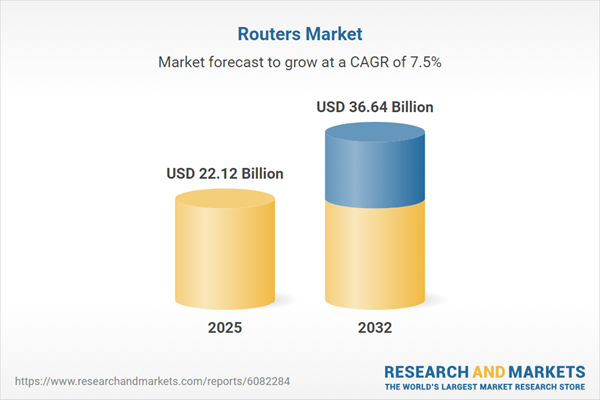Speak directly to the analyst to clarify any post sales queries you may have.
The routers market is evolving rapidly as organizations intensify digital transformation efforts and demand greater security, speed, and dependability from network infrastructure. Senior decision-makers face increasing complexity as enterprise requirements change, technology diversifies, and new regulatory challenges arise, creating a need for clear, actionable market intelligence to guide future connectivity strategies.
Market Snapshot: Routers Market Size and Growth Outlook
The global routers market is advancing, valued at USD 20.61 billion in 2024 and projected to increase to USD 22.12 billion in 2025. By 2032, industry analysts expect the market to reach USD 36.64 billion, representing a CAGR of 7.45%. This growth stems from escalating demands for versatile networking, widespread cloud computing adoption, expansion of IoT devices, and increasingly robust mobile broadband use cases. Market expansion highlights the urgent need for enterprises, telecom operators, and service providers to stay ahead of disruptions and embrace evolving connectivity frameworks.
Scope & Segmentation: Routers Market Breakdown
This in-depth report provides a comprehensive overview, helping senior executives identify future market opportunities and potential risks. Segment analysis enables organizations to align strategies with real-world buying behavior, regulatory influences, and localized technology trends.
- Product Types: Includes core routers, edge routers, aggregation routers, customer premises equipment, industrial routers, virtual routers, wired routers, and wireless routers, each suited for differing deployment scenarios within enterprise, telecom, and industrial environments.
- Device Types: Covers carrier grade routers, enterprise routers, home routers, industrial routers, and service provider routers, reflecting the diversified user base and unique networking needs across verticals.
- Technologies: Encompasses Wi-Fi 5, Wi-Fi 6, Wi-Fi 6E, and Wi-Fi 7, showing the shift toward higher performance, reduced latency, and improved spectral efficiency.
- Connectivity: Differentiates between wired and wireless solutions to support flexible, reliable deployment in both established and emerging enterprises.
- Frequency Bands: Assesses dual band, single band, and tri band options, catering to tailored throughput and device density requirements.
- Installation Environments: Incorporates both indoor and outdoor implementations to address varying operational demands.
- End Users: Analyzes consumer, large enterprise, and telecom service provider segments, accounting for varied infrastructure investments and digitalization efforts.
- Distribution Channels: Outlines offline, distributor, retail store, online, direct sales, and e-commerce channels, illustrating the diversity of procurement preferences across regions.
- Regions Covered: Explores the Americas, Europe, Middle East & Africa, and Asia-Pacific, with regional trends detailed for North America, Latin America, Europe, Middle East, Africa, and Asia-Pacific, reflecting the nuances of growth and policy direction in each market.
- Key Companies: Profiles Cisco Systems, Huawei Technologies, Nokia Corporation, Juniper Networks, ZTE Corporation, Ciena Corporation, Ericsson, Hewlett Packard Enterprise, NEC Corporation, and Dell Technologies, leading the competitive landscape.
Key Takeaways for Senior Stakeholders
- Network virtualization and the evolution of advanced Wi-Fi standards are systematically changing router design, enabling seamless integration into cloud, IoT, and edge computing projects.
- Heightened focus on security and energy efficiency is driving both product development and procurement, as buyers seek solutions aligned with sustainability and compliance aspirations.
- Solution portfolios are becoming more specialized, targeting the unique challenges of enterprise, industrial, and consumer sectors and supporting wide-ranging digitalization initiatives.
- Global procurement strategies are adapting in response to increased supply chain scrutiny, with resilience and agility prioritized to mitigate shifting trade regulations and ensure supply continuity.
- The rollout of new regional connectivity infrastructure, such as fiber networks and 5G deployments, is generating significant opportunities for optimized router adoption and ecosystem development.
- Strategic partnerships with standards bodies and cybersecurity or cloud service leaders are accelerating innovation and meeting the evolving requirements of connected enterprises.
Tariff Impact on Router Supply Chains
The introduction of US tariffs on networking components in 2025 has altered procurement dynamics, raising input costs and prompting organizations to diversify suppliers. In response, manufacturers are expanding production in regions offering favorable trade terms. This transition raises supply chain management complexity, putting renewed focus on quality controls, enhancing regional manufacturing readiness, and developing workforce expertise. A strategic shift toward modular and software-centric routers helps network operators stabilize costs and buffer their infrastructure from policy-driven volatility.
Methodology & Data Sources
Market findings in this report are the result of primary research, in-depth expert interviews, and validated secondary sources such as industry publications and official regulatory documents. The analysis employs triangulation methods, PESTLE frameworks, and cross-verification via shipment and compliance records for unbiased, data-driven insights.
Why This Report Matters for Router Market Strategy
- Empowers organizations with advanced segmentation and actionable intelligence to optimize investments and speed up technology adoption in varied operational environments.
- Clarifies strategic sourcing and deployment approaches, enabling greater resilience despite evolving regulatory and trade scenarios.
- Supports benchmarking, guides competitive positioning, and enables development of effective regional go-to-market frameworks tailored to sector-specific needs.
Conclusion
The global routers market is entering a pivotal phase, shaped by rapid technology, regulatory shifts, and evolving enterprise requirements. Success in this sector will depend on leveraging precise market data and withstanding ongoing market transformation through agile strategic planning.
Table of Contents
3. Executive Summary
4. Market Overview
7. Cumulative Impact of Artificial Intelligence 2025
Companies Mentioned
The companies profiled in this Routers market report include:- Cisco Systems, Inc.
- Huawei Technologies Co., Ltd.
- Nokia Corporation
- Juniper Networks, Inc.
- ZTE Corporation
- Ciena Corporation
- Telefonaktiebolaget LM Ericsson
- Hewlett Packard Enterprise Company
- NEC Corporation
- Dell Technologies Inc.
Table Information
| Report Attribute | Details |
|---|---|
| No. of Pages | 187 |
| Published | November 2025 |
| Forecast Period | 2025 - 2032 |
| Estimated Market Value ( USD | $ 22.12 Billion |
| Forecasted Market Value ( USD | $ 36.64 Billion |
| Compound Annual Growth Rate | 7.4% |
| Regions Covered | Global |
| No. of Companies Mentioned | 11 |









